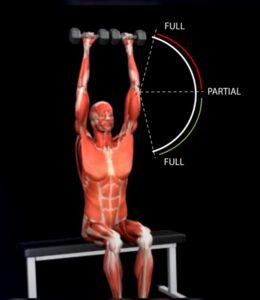If your shoulders aren’t growing three-dimensionally, you might miss out on achieving a V-shaped upper body, losing the chance to enhance your overall lean, attractive, and athletic look. Additionally, the lack of shoulder development may hinder the creation of distinct shoulder muscles that stand out from the rest of your muscle mass.
Unfortunately, many men make the same common mistakes that prevent them from adding any significant mass to their shoulders. So, here I’m about to talk about the most common mistakes that are preventing you from bulking up your shoulders.
You don’t train through a full range of motion

Next time you do overhead presses, take a look at how most people perform the exercise. If you can go all the way down on the press, you’re doing it right. Most people press the weight back up to where their upper arms are parallel to the floor. Then, they lower the weight down to where their hands are at least at ear level. You can lower the weight even lower until the dumbbells are at the same height as your shoulders.
During the lower middle of the motion, the delts are mostly stimulated. This is beneficial because the bottom part of the overhead press is the part that primarily stimulates the deltoids. On the other hand, the upper part is largely a function of the triceps. If we divide the motion of an overhead press into a lower middle and upper portion, we can see that the triceps are heavily involved in locking out the weight during that upper portion.
Full-range squats stimulate muscle growth more than partial squats
Your shoulders are fired up in the lower and middle portions of this exercise, in addition to them being more active in the lower and middle sections. This is likely due to the greater range of motion involved in this exercise.
Research indicates that training through a wider range of motion is better for muscle growth. Research suggests that full-range squats are more effective than partial squats in stimulating muscle growth, while curls are more beneficial to biceps development than partial curls.
Overemphasize the front delts, while neglecting the side and rear delts
Another common mistake is that you’re focusing too much on the front delts, but not enough on the side and the rear delts. This is usually done unintentionally, and this issue can even affect advanced bodybuilders. Forming a disproportionate amount of volume for your front, delts is common for two reasons.
First, one of the most staple shoulder exercises in everyone’s routine is the overhead press. Unfortunately, the overhead press is not as effective an exercise as it focuses primarily on the front delts. Meanwhile, the sides, and especially the rear delts, get much less activation. The second and also the biggest issue is the fact that you already train your front delts quite a bit during all your horizontal pressing exercises like the dumbbell and barbell bench press.
So, when you are training your chest, your shoulders, and your back, you are also working on your deltoids to some degree. This is especially true when you are doing exercises like pull-ups, rows, and bent-over rows.
But that is not the case with side delts. These are especially helpful for giving your shoulders that wide look except for upright rows, which can lead to shoulder impingement. Unlike most other compound exercises, including bench presses, pull-ups, and rows, your side delts are not activated to a great extent.
Aside from the aesthetic benefits, focusing on the side and rear delts is also beneficial for posture and shoulder health. A recent study published in the Journal of Clinical Biomechanics finds that training deltoids on either side of the body can help protect your shoulder joint, reduce the risk of injury, and increase your overall muscular tone.
Leaving your shoulder exercises until the very end of your workout
However, many people who want to grow their shoulders do not train their shoulders. First, determine whether your split training routine combines chest, shoulders, and triceps. For a typical push-heavy workout, you might start with bench presses and dumbbell presses, which will exhaust your shoulders before you get to exercises that use your shoulders more explosively, such as shoulder presses.

If you’re primarily focused on growing your chest, your workout routine will be fine if you start with exercises that target your chest muscles. However, if you want to achieve better shoulder development, it would be advisable to focus on working your shoulders first during your workout.
By combining different arm workouts on separate days, you can favor different muscle groups more effectively. By working out the shoulders, biceps, and triceps on separate days, you can help ensure that each muscle group gets the attention it deserves.
Raises and dumbbell reverse flies can wind up being extremely beneficial for balancing out the shape of your shoulders. When you begin the workout with overhead presses, which target more of your front delts, starting with shoulder exercises can help you lift significantly more weight than if you finished with shoulder exercises, which will benefit muscle growth.
Allowing your traps to take over your delts
Another mistake is allowing your traps to take over for your delts. This isn’t the case for everyone, but some people feel shoulder exercises and especially side-d dealt exercises more in their traps than they do in their shoulders.
Due to the increase in traps being activated, the traps have grown in size, while the shoulders may lag. With this increased level of trap activation, their traps grow like crazy, while their shoulders get left behind. This can be a difficult situation because it is impossible to stimulate your delts without also engaging your traps in the movement. The good news is that there are a few things you can do to reduce trap recruitment.
First, you should static stretch your traps before you do your shoulder workout. Several studies have found that stretching a muscle for 60 seconds or more reduces subsequent muscle activation during exercise. Simply bending one arm and placing it behind your back will effectively stretch your traps.
Applying progressive overloading
Many weightlifters try to beat the weight they lifted the previous week or month. This is a good thing because increasing the amount of stress you place on your muscles stimulates growth. However, it’s critical not to overdo it and to allow your body time to recover.
But I find very few people who are focused on trying to increase the amount of weight that they can use on compound shoulder exercises like overhead presses and especially on isolation exercises like lateral raises. That’s a big mistake when doing shoulder exercises or any other exercise for that matter. You want to focus on progressive overload. This means that you have to gradually increase the amount of workload that you put on a muscle. It doesn’t need to be a huge increase.
Small weight-lifting increments will add up to large increments over time, so focus on just increasing the amount of weight you can lift by even two and a half pounds in one month. If you’re doing a weight load for 10 reps and not hitting fan failure increase that weight load until you’re doing like six or seven reps before hitting failure, then work on getting your rep count back up to 9 or 10 reps before upping the weight load again and repeating that entire process.
This is also why it could be highly beneficial for you to keep track of your workouts. This is so that you know how much weight you used during your last couple of workouts and how many reps you were able to do with that weight. This way, you’ll always have a measurable number to beat over time.
You are not doing enough overall training volume
Another issue you might be running into aside from just not upping your weight load is you’re not doing enough overall training volume.
How many sets and repetitions should you do?

If you only do a couple of sets here and there, you need to do more training volume to get the best results. More sets and repetitions will result in more muscle growth. The meta-analysis found a dose-response relationship between training volume and muscle growth in trained lifters. The more sets the participants did, the more muscle they gained. This was seen in another eight-week study where participants did three or five sets of each exercise. The results once again showed that there was a dose-response relationship where higher training volumes led to more muscle growth.
So, if your shoulders aren’t growing, try doing more sets for that muscle every week. If you’re currently doing nine sets of shoulder exercises per week, try working your muscles even more by doing 12 or 15 sets per week. This might help you break through your plateau and see some new gains in your shoulder strength and size.
Add mass to your shoulder
Sure, working out and eating healthy are both important. However, if you’re not consistently fueling your body with enough calories, your muscles will not get the fuel they need to grow.
Consuming enough calories is crucial if you want to maximize muscle growth. If your shoulders are not growing, it may be because you are consuming more calories than you are burning. If this is the case, you may need to adjust your caloric intake to get your shoulders growing again. Keep in mind, that you don’t have to go crazy stuffing yourself with as much food as possible to maximize muscle growth.
When you have a high-calorie surplus, your body can’t use all of the energy it’s getting, and it starts to store it as fat. This can lead to weight gain, fatigue, and cravings for energy-dense foods. Instead, focus on eating a balanced diet that includes healthy sources of protein, healthy fats, and fiber. You’ll get the energy you need and stay healthy overall.
This was proven in a study where a scientist compared muscle growth and fat gain in individuals who had different calorie surpluses. While one group consumed a regular calorie surplus, the other group consumed 600 calories more than the surplus group. After 12 weeks, both groups gained a statistically similar amount of muscle. However, the group that consumed an additional 600 calories gained more than five times the amount of fat.
So, if you want to keep things simple, I recommend that you consume a calorie surplus target of around five to eight percent above maintenance per day. That will be enough to maximize muscle growth while minimizing fat gain.
Not getting enough protein
Finally, last but not least, you may not be eating enough protein. So, not only is getting enough calories important for muscle growth, but you also want to consume enough protein. That’s because the amino acids found in protein form the foundation of our muscle mass. Muscle growth is all about building up more protein in a muscle compared to what gets broken down daily. If you can accomplish that, your muscles will start to grow right away. Your muscles will start to develop definition. Just like with the calorie surplus, more is not necessarily more. A 2018 meta-analysis published in the British Journal of Sports Medicine found that you only need 0.
3 grams of protein per pound of body weight per day is the recommended amount to maintain overall health. For a 180-pound person, this would equal 131 grams of protein. Based on the available scientific evidence, it is unlikely that consuming more protein than the recommended amount will have a significant impact on your muscle-building progress.
Instead, I recommend saving those additional calories for fats and carbs that can make your diet more enjoyable, so that about wraps it up.
Leave a Reply